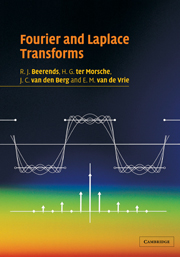Book contents
- Frontmatter
- Contents
- Preface
- Introduction
- Part 1 Applications and foundations
- Part 2 Fourier series
- 3 Fourier series: definition and properties
- 4 The fundamental theorem of Fourier series
- 5 Applications of Fourier series
- Part 3 Fourier integrals and distributions
- Part 4 Laplace transforms
- Part 5 Discrete transforms
- Literature
- Tables of transforms and properties
- Index
4 - The fundamental theorem of Fourier series
Published online by Cambridge University Press: 05 June 2012
- Frontmatter
- Contents
- Preface
- Introduction
- Part 1 Applications and foundations
- Part 2 Fourier series
- 3 Fourier series: definition and properties
- 4 The fundamental theorem of Fourier series
- 5 Applications of Fourier series
- Part 3 Fourier integrals and distributions
- Part 4 Laplace transforms
- Part 5 Discrete transforms
- Literature
- Tables of transforms and properties
- Index
Summary
INTRODUCTION
Chapter 3 has been a first introduction to Fourier series. These series can be associated with periodic functions. We also noted in chapter 3 that if the function satisfies certain conditions, the Fourier series converges to the periodic function. What these specific conditions should be has not been analysed in chapter 3. The conditions that will be imposed in this book imply that the function should be piecewise smooth. In this chapter we will prove that a Fourier series of a piecewise smooth periodic function converges pointwise to the periodic function. We stress here that this condition is sufficient: when it holds, the series is pointwise convergent. This condition does not cover all cases of pointwise convergence and is thus not necessary for convergence.
In the first section of this chapter we derive a number of properties of Fourier coefficients that will be useful in the second section, where we prove the fundamental theorem. In the fundamental theorem we prove that for a piecewise smooth periodic function the Fourier series converges to the function. In the third section we then derive some further properties of Fourier series: product and convolution, Parseval's theorem (which has applications in the analysis of systems and signals), and integration and differentiation of Fourier series. We end this chapter with the treatment of Gibbs' phenomenon, which describes the convergence behaviour of the Fourier series at a jump discontinuity.
- Type
- Chapter
- Information
- Fourier and Laplace Transforms , pp. 86 - 112Publisher: Cambridge University PressPrint publication year: 2003



